2007 CHEVROLET EXPRESS PASSANGER seats
[x] Cancel search: seatsPage 49 of 458
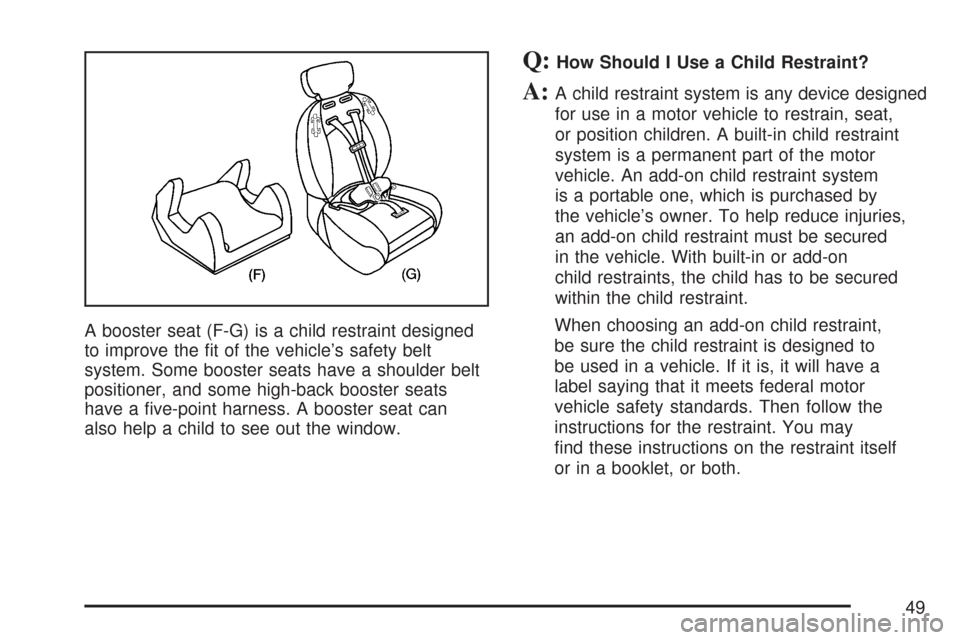
A booster seat (F-G) is a child restraint designed
to improve the fit of the vehicle’s safety belt
system. Some booster seats have a shoulder belt
positioner, and some high-back booster seats
have a five-point harness. A booster seat can
also help a child to see out the window.
Q:How Should I Use a Child Restraint?
A:A child restraint system is any device designed
for use in a motor vehicle to restrain, seat,
or position children. A built-in child restraint
system is a permanent part of the motor
vehicle. An add-on child restraint system
is a portable one, which is purchased by
the vehicle’s owner. To help reduce injuries,
an add-on child restraint must be secured
in the vehicle. With built-in or add-on
child restraints, the child has to be secured
within the child restraint.
When choosing an add-on child restraint,
be sure the child restraint is designed to
be used in a vehicle. If it is, it will have a
label saying that it meets federal motor
vehicle safety standards. Then follow the
instructions for the restraint. You may
find these instructions on the restraint itself
or in a booklet, or both.
49
Page 50 of 458
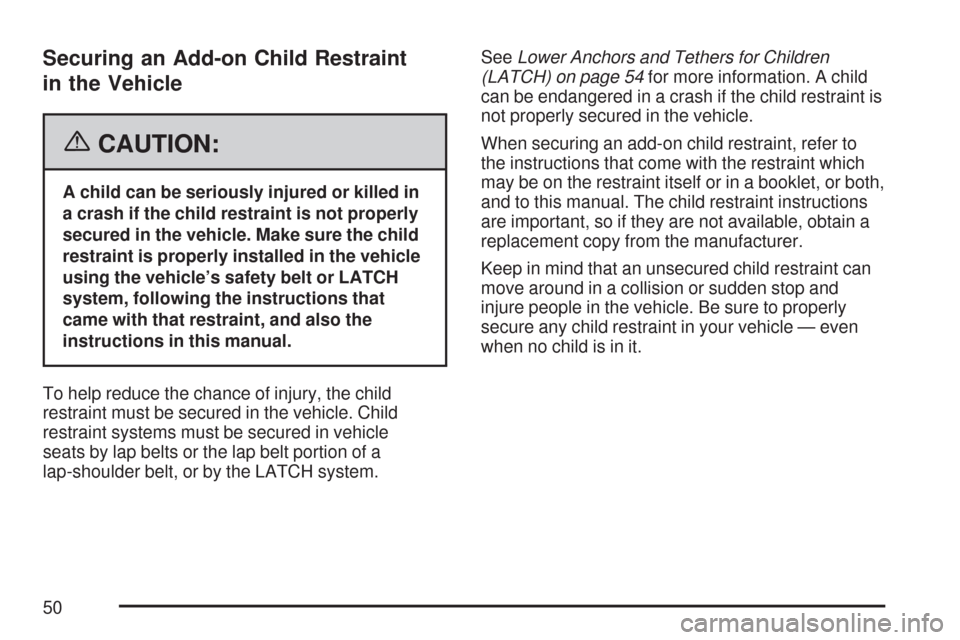
Securing an Add-on Child Restraint
in the Vehicle
{CAUTION:
A child can be seriously injured or killed in
a crash if the child restraint is not properly
secured in the vehicle. Make sure the child
restraint is properly installed in the vehicle
using the vehicle’s safety belt or LATCH
system, following the instructions that
came with that restraint, and also the
instructions in this manual.
To help reduce the chance of injury, the child
restraint must be secured in the vehicle. Child
restraint systems must be secured in vehicle
seats by lap belts or the lap belt portion of a
lap-shoulder belt, or by the LATCH system.SeeLower Anchors and Tethers for Children
(LATCH) on page 54for more information. A child
can be endangered in a crash if the child restraint is
not properly secured in the vehicle.
When securing an add-on child restraint, refer to
the instructions that come with the restraint which
may be on the restraint itself or in a booklet, or both,
and to this manual. The child restraint instructions
are important, so if they are not available, obtain a
replacement copy from the manufacturer.
Keep in mind that an unsecured child restraint can
move around in a collision or sudden stop and
injure people in the vehicle. Be sure to properly
secure any child restraint in your vehicle — even
when no child is in it.
50
Page 69 of 458
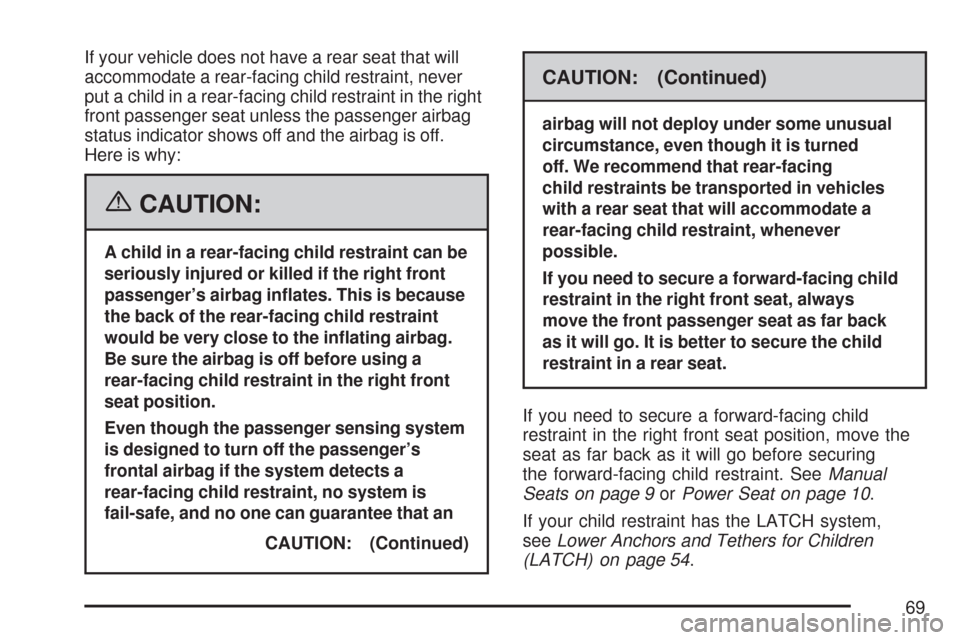
If your vehicle does not have a rear seat that will
accommodate a rear-facing child restraint, never
put a child in a rear-facing child restraint in the right
front passenger seat unless the passenger airbag
status indicator shows off and the airbag is off.
Here is why:
{CAUTION:
A child in a rear-facing child restraint can be
seriously injured or killed if the right front
passenger’s airbag in�ates. This is because
the back of the rear-facing child restraint
would be very close to the in�ating airbag.
Be sure the airbag is off before using a
rear-facing child restraint in the right front
seat position.
Even though the passenger sensing system
is designed to turn off the passenger’s
frontal airbag if the system detects a
rear-facing child restraint, no system is
fail-safe, and no one can guarantee that an
CAUTION: (Continued)
CAUTION: (Continued)
airbag will not deploy under some unusual
circumstance, even though it is turned
off. We recommend that rear-facing
child restraints be transported in vehicles
with a rear seat that will accommodate a
rear-facing child restraint, whenever
possible.
If you need to secure a forward-facing child
restraint in the right front seat, always
move the front passenger seat as far back
as it will go. It is better to secure the child
restraint in a rear seat.
If you need to secure a forward-facing child
restraint in the right front seat position, move the
seat as far back as it will go before securing
the forward-facing child restraint. SeeManual
Seats on page 9orPower Seat on page 10.
If your child restraint has the LATCH system,
seeLower Anchors and Tethers for Children
(LATCH) on page 54.
69
Page 70 of 458
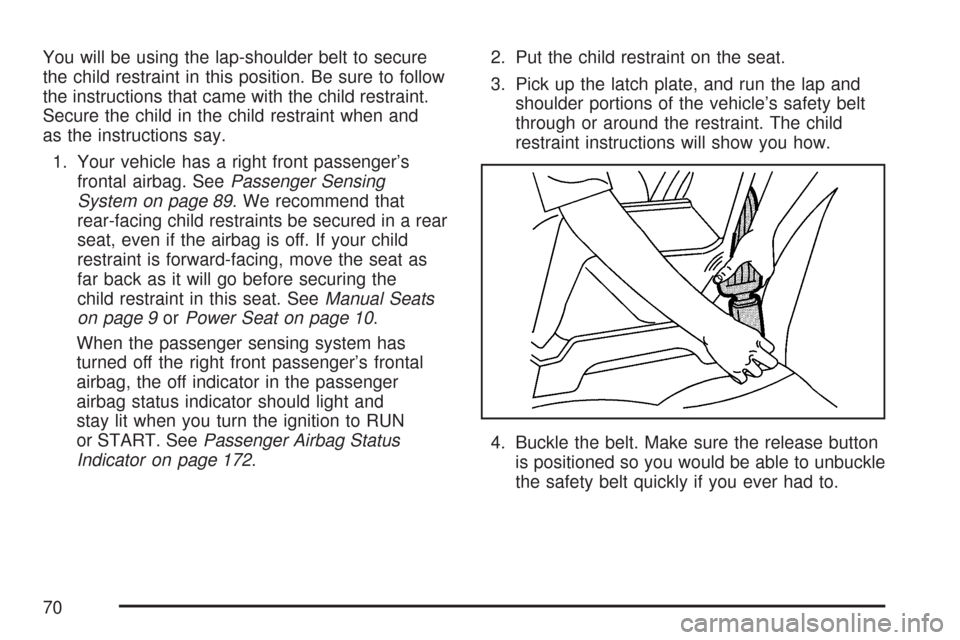
You will be using the lap-shoulder belt to secure
the child restraint in this position. Be sure to follow
the instructions that came with the child restraint.
Secure the child in the child restraint when and
as the instructions say.
1. Your vehicle has a right front passenger’s
frontal airbag. SeePassenger Sensing
System on page 89. We recommend that
rear-facing child restraints be secured in a rear
seat, even if the airbag is off. If your child
restraint is forward-facing, move the seat as
far back as it will go before securing the
child restraint in this seat. SeeManual Seats
on page 9orPower Seat on page 10.
When the passenger sensing system has
turned off the right front passenger’s frontal
airbag, the off indicator in the passenger
airbag status indicator should light and
stay lit when you turn the ignition to RUN
or START. SeePassenger Airbag Status
Indicator on page 172.2. Put the child restraint on the seat.
3. Pick up the latch plate, and run the lap and
shoulder portions of the vehicle’s safety belt
through or around the restraint. The child
restraint instructions will show you how.
4. Buckle the belt. Make sure the release button
is positioned so you would be able to unbuckle
the safety belt quickly if you ever had to.
70
Page 74 of 458
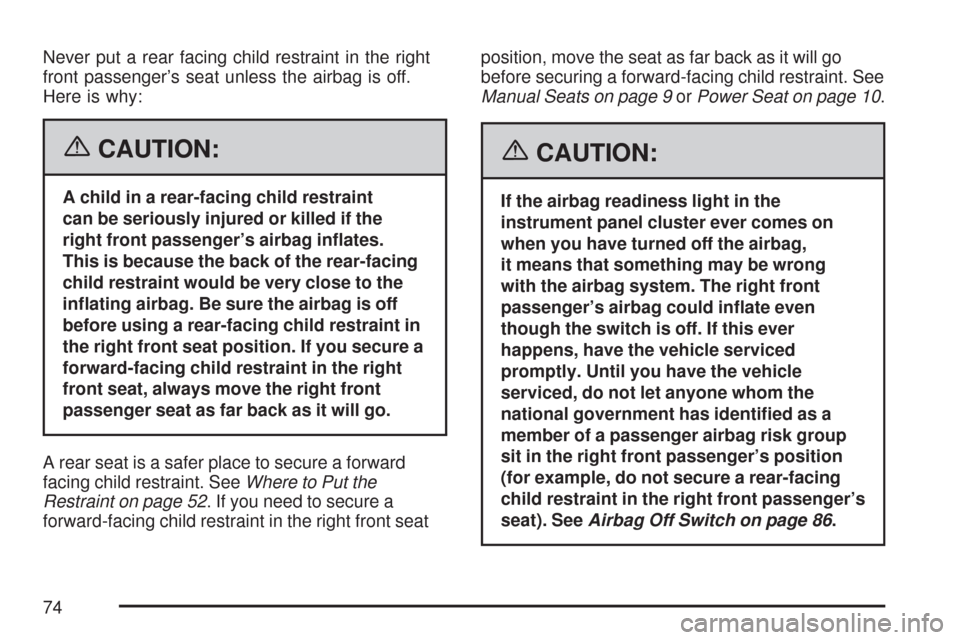
Never put a rear facing child restraint in the right
front passenger’s seat unless the airbag is off.
Here is why:
{CAUTION:
A child in a rear-facing child restraint
can be seriously injured or killed if the
right front passenger’s airbag in�ates.
This is because the back of the rear-facing
child restraint would be very close to the
in�ating airbag. Be sure the airbag is off
before using a rear-facing child restraint in
the right front seat position. If you secure a
forward-facing child restraint in the right
front seat, always move the right front
passenger seat as far back as it will go.
A rear seat is a safer place to secure a forward
facing child restraint. SeeWhere to Put the
Restraint on page 52. If you need to secure a
forward-facing child restraint in the right front seatposition, move the seat as far back as it will go
before securing a forward-facing child restraint. See
Manual Seats on page 9orPower Seat on page 10.
{CAUTION:
If the airbag readiness light in the
instrument panel cluster ever comes on
when you have turned off the airbag,
it means that something may be wrong
with the airbag system. The right front
passenger’s airbag could in�ate even
though the switch is off. If this ever
happens, have the vehicle serviced
promptly. Until you have the vehicle
serviced, do not let anyone whom the
national government has identi�ed as a
member of a passenger airbag risk group
sit in the right front passenger’s position
(for example, do not secure a rear-facing
child restraint in the right front passenger’s
seat). SeeAirbag Off Switch on page 86.
74
Page 75 of 458
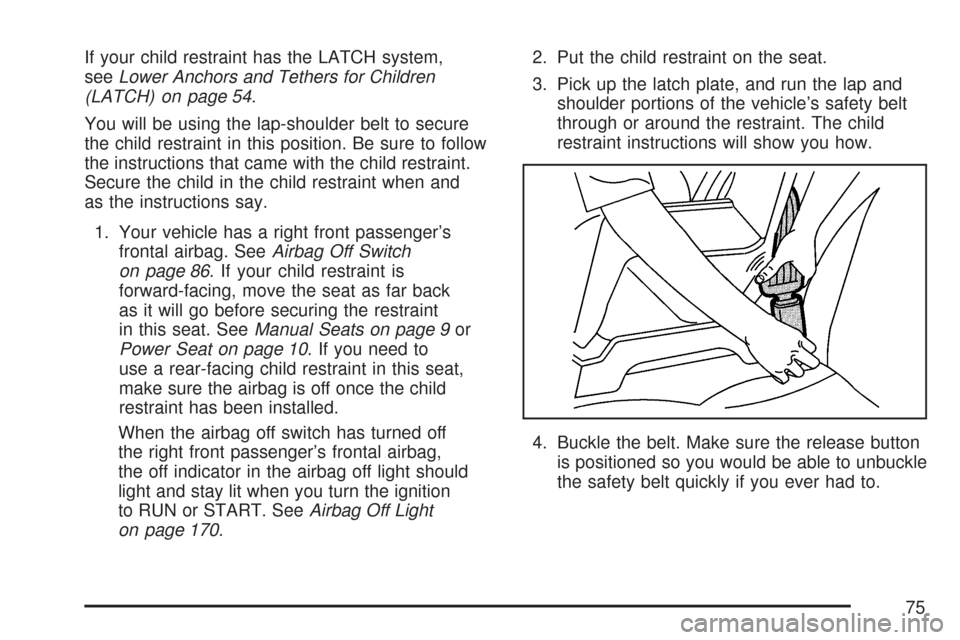
If your child restraint has the LATCH system,
seeLower Anchors and Tethers for Children
(LATCH) on page 54.
You will be using the lap-shoulder belt to secure
the child restraint in this position. Be sure to follow
the instructions that came with the child restraint.
Secure the child in the child restraint when and
as the instructions say.
1. Your vehicle has a right front passenger’s
frontal airbag. SeeAirbag Off Switch
on page 86. If your child restraint is
forward-facing, move the seat as far back
as it will go before securing the restraint
in this seat. SeeManual Seats on page 9or
Power Seat on page 10. If you need to
use a rear-facing child restraint in this seat,
make sure the airbag is off once the child
restraint has been installed.
When the airbag off switch has turned off
the right front passenger’s frontal airbag,
the off indicator in the airbag off light should
light and stay lit when you turn the ignition
to RUN or START. SeeAirbag Off Light
on page 170.2. Put the child restraint on the seat.
3. Pick up the latch plate, and run the lap and
shoulder portions of the vehicle’s safety belt
through or around the restraint. The child
restraint instructions will show you how.
4. Buckle the belt. Make sure the release button
is positioned so you would be able to unbuckle
the safety belt quickly if you ever had to.
75
Page 83 of 458

In any particular crash, no one can say whether
an airbag should have inflated simply because
of the damage to a vehicle or because of what
the repair costs were. Inflation is determined
by what the vehicle hits, the angle of the impact,
and how quickly the vehicle slows down in front
or near-frontal impacts.
If the GVWR (Gross Vehicle Weight Rating) of
your vehicle is 8,500 lb (3 855 kg) or above, your
vehicle has single stage airbags. If the GVWR
is below 8,500 lb (3 855 kg), your vehicle has dual
stage airbags. You can find the GVWR on the
certification label on the rear edge of the driver’s
door. SeeLoading Your Vehicle on page 261
for more information.
Single Stage Airbags
If your vehicle has frontal airbags with single stage
deployment and your vehicle goes straight into
a wall that does not move or deform, the threshold
level is about 9 to 16 mph (14 to 26 km/h). The
threshold level can vary, however, with specific
vehicle design, so that it can be somewhat above
or below this range.
Dual Stage Airbags
If your vehicle has frontal airbags with dual stage
deployment, the restraint will adjust according
to the crash severity. Your vehicle has electronic
frontal sensors which helps the sensing system
distinguish between a moderate and a more
severe frontal impact. For moderate frontal
impacts, these airbags inflate at a level less
than full deployment. For more severe frontal
impacts, full deployment occurs. If the front of
your vehicle goes straight into a wall that does
not move or deform, the threshold level for the
reduced deployment is about 12 to 16 mph
(19 to 26 km/h), and the threshold level for a full
deployment is about 18 to 25 mph (29 to 40 km/h).
The threshold level can vary, however, with
specific vehicle design, so that it can be somewhat
above or below this range.
Vehicles with dual stage airbags also have
sensors which enable the sensing system to
monitor the position of both the driver and
passenger front seats. The seat position sensors
provide information which is used to determine
if the airbags should deploy at a reduced level
or at full deployment.
83
Page 97 of 458

Adding Equipment to Your
Airbag-Equipped Vehicle
Q:Is there anything I might add to the
exterior of the vehicle that could keep
the airbags from working properly?
A:Yes. If you add things that change your
vehicle’s frame, bumper system, height,
front end or side sheet metal, they may keep
the airbag system from working properly.
Also, the airbag system may not work properly
if you relocate any of the airbag sensors.
If you have any questions about this,
you should contact Customer Assistance
before you modify your vehicle. The phone
numbers and addresses for Customer
Assistance are in Step Two of the Customer
Satisfaction Procedure in this manual.
SeeCustomer Satisfaction Procedure
on page 424.
Q:Because I have a disability, I have to get
my vehicle modi�ed. How can I �nd out
whether this will affect my airbag system?
A:Changing or moving any parts of the
front seats, safety belts, the airbag sensing
and diagnostic module, steering wheel,
the instrument panel, or airbag wiring can
affect the operation of the airbag system.
If you have questions, call Customer
Assistance. The phone numbers and
addresses for Customer Assistance are
in Step Two of the Customer Satisfaction
Procedure in this manual. SeeCustomer
Satisfaction Procedure on page 424.
Your dealer/retailer and the service manual
have information about the location of the airbag
sensors, sensing and diagnostic module and
airbag wiring.
97